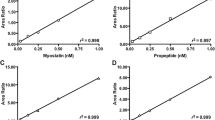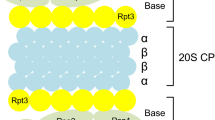Abstract
Muscle wasting or cachexia is commonly associated with aging and many diseases such as cancer, infection, autoimmune disorders, and trauma. Decrease in muscle mass, or muscle atrophy, is often caused by dysfunction of protein proteolytic systems, such as lysosomes, which regulate protein turnover and homeostasis. Lysosomes contain many hydrolases and proteases and, thus, represent the major organelle that control protein turnover. Recently, lysosomes have emerged as a signaling hub to integrate cellular functions of nutrient sensing and metabolism, autophagy, phagocytosis, and endocytosis, which are all related to tissue homeostasis. In this chapter, we describe the protocol used to measure lysosomal proteinase (cathepsins) activity in the skeletal muscle. A better understanding of lysosomal function in muscle homeostasis is critical in developing new therapeutic approaches to prevent muscle wasting.
Similar content being viewed by others
References
Bonaldo P, Sandri M (2013) Cellular and molecular mechanisms of muscle atrophy. Dis Model Mech 6:25–39
Sakuma K, Aoi W, Yamaguchi A (2017) Molecular mechanism of sarcopenia and cachexia: recent research advances. Pflugers Arch 469(5-6):573–591
Narici MV, de Boer MD (2011) Disuse of the musculo-skeletal system in space and on earth. Eur J Appl Physiol 111:403–420
Chopard A, Hillock S, Jasmin BJ (2009) Molecular events and signalling pathways involved in skeletal muscle disuse-induced atrophy and the impact of countermeasures. J Cell Mol Med 13:3032–3050
Bialek P, Morris C, Parkington J, St Andre M, Owens J, Yaworsky P, Seeherman H, Jelinsky SA (2011) Distinct protein degradation profiles are induced by different disuse models of skeletal muscle atrophy. Physiol Genomics 43:1075–1086
Xu H, Ren D (2015) Lysosomal physiology. Annu Rev Physiol 77:57–80
Xiong J, Zhu MX (2016) Regulation of lysosomal ion homeostasis by channels and transporters. Sci China Life Sci 59:777–791
Stoka V, Turk V, Turk B (2016) Lysosomal cathepsins and their regulation in aging and neurodegeneration. Ageing Res Rev 32:22–37
Aversa Z, Pin F, Lucia S, Penna F, Verzaro R, Fazi M, Colasante G, Tirone A, Rossi Fanelli F, Ramaccini C, Costelli P, Muscaritoli M (2016) Autophagy is induced in the skeletal muscle of cachectic cancer patients. Sci Rep 6:30340
Eskelinen EL, Saftig P (2009) Autophagy: a lysosomal degradation pathway with a central role in health and disease. Biochim Biophys Acta 1793:664–673
Reiser J, Adair B, Reinheckel T (2010) Specialized roles for cysteine cathepsins in health and disease. J Clin Invest 120:3421–3431
Mohamed MM, Sloane BF (2006) Cysteine cathepsins: multifunctional enzymes in cancer. Nat Rev Cancer 6:764–775
Choe Y, Leonetti F, Greenbaum DC, Lecaille F, Bogyo M, Bromme D, Ellman JA, Craik CS (2006) Substrate profiling of cysteine proteases using a combinatorial peptide library identifies functionally unique specificities. J Biol Chem 281:12824–12832
Schroter J, Schott KJ, Purtill MA, Neuhoff V (1986) Lysosomal protein degradation in experimental hyperphenylalaninaemia. J Inherit Metab Dis 9:273–282
Creasy BM, Hartmann CB, White FK, McCoy KL (2007) New assay using fluorogenic substrates and immunofluorescence staining to measure cysteine cathepsin activity in live cell subpopulations. Cytometry A 71:114–123
Rossman MD, Maida BT, Douglas SD (1990) Monocyte-derived macrophage and alveolar macrophage fibronectin production and cathepsin D activity. Cell Immunol 126:268–277
Wilder CL, Park KY, Keegan PM, Platt MO (2011) Manipulating substrate and pH in zymography protocols selectively distinguishes cathepsins K, L, S, and V activity in cells and tissues. Arch Biochem Biophys 516:52–57
Jang BG, Choi BY, Kim JH, Kim MJ, Sohn M, Suh SW (2013) Impairment of autophagic flux promotes glucose reperfusion-induced neuro2A cell death after glucose deprivation. PLoS One 8:e76466
Lin PH, Duann P, Komazaki S, Park KH, Li H, Sun M, Sermersheim M, Gumpper K, Parrington J, Galione A, Evans AM, Zhu MX, Ma J (2015) Lysosomal two-pore channel subtype 2 (TPC2) regulates skeletal muscle autophagic signaling. J Biol Chem 290:3377–3389
Acknowledgments
This work was supported by NIH grant R01GM092759 (to M.X.Z) and an Ohio State University intramural Lockwood Research grant (to P.H.L).
Author information
Authors and Affiliations
Corresponding author
Editor information
Editors and Affiliations
Rights and permissions
Copyright information
© 2017 Springer Science+Business Media New York
About this protocol
Cite this protocol
Gumpper, K., Sermersheim, M., Zhu, M.X., Lin, PH. (2017). Skeletal Muscle Lysosomal Function via Cathepsin Activity Measurement. In: Turksen, K. (eds) Autophagy in Differentiation and Tissue Maintenance. Methods in Molecular Biology, vol 1854. Humana Press, New York, NY. https://doi.org/10.1007/7651_2017_64
Download citation
DOI: https://doi.org/10.1007/7651_2017_64
Published:
Publisher Name: Humana Press, New York, NY
Print ISBN: 978-1-4939-8747-4
Online ISBN: 978-1-4939-8748-1
eBook Packages: Springer Protocols




